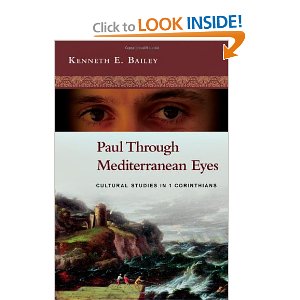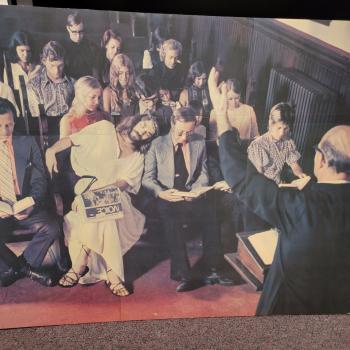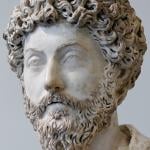One of the keys to understanding 1 Corinthians is recognizing the very nature of ancient texts like 1 Corinthians. They were written in scriptum continuum, a continuous flow of letters and lines. The problem with ring or chiastic structure is it needs to be seen to be recognized. But when you have scriptum continuum, even the person who is literate and has eyes to see would have a very difficult time finding chiasms that stretch over whole chapters and more. It has been said that a chiasm is often in the eye of the beholder, but 1 Corinthians was not written for the eye, it was written for the ears of the listeners of this discourse in Corinth. While some of the smaller chiasms Bailey finds seem possible, perhaps especially the ones that involve four lines or phrases in ABBA pattern, most of the elaborate ring structures Bailey comes up with are unconvincing and even if Paul had intended them they would have gone unnoticed by the audience.
Only the lector who read out the document to the congregation might have gotten a glimpse of such visual grand structures, but alas, the document was not written as a discourse primarily for him or his eyes, even if he was a Timothy. Finally there is this. While Paul and others had been studying a text like Isaiah for a very long time, and likely had access through the synagogue to an Isaiah scroll and others, no such situation existed in Corinth when it comes to a discourse like 1 Corinthians which the audience was hearing for the first time when it was delivered orally by a Timothy or someone else. Discovering chiasms, especially lengthy ones in text requires long study and meditation on such texts. The Corinthians, unlike Bailey had no such opportunities to do so when it comes to Corinthians, nor do we have any reason to think the audience would have been thinking of long structural comparisons with things going on in Isaiah and elsewhere, because Paul does not quote at length from OT texts in this document. He quotes phrases, brief sentences and the like. This would not immediately prompt in the audience the thought— ‘oh, he is using this big ring structure in 2nd Isaiah’.
In the proper first chapter (pp. 55-63) which deals with the prescript and the opening prayer and remarks of Paul, Bailey begins to unfold his theories about this discourse. In short, everything hinges on this document being intended not just for Corinth but for all the churches as well, which explains, in Bailey’s view, why it has a different structure from various of Paul’s more ‘ad hoc’ or specific letters, explains why Paul uses endless ring structures (which he calls polished rhetoric) and five essays to make his points in this letter. The problem is, 1 Corinthians doesn’t really manifest all those ring structures any more than say Philippians or 1 Thessalonians or Romans does. The beauty in this case is in the eye of the beholder. 1 Corinthians is just as ‘linear’ a set of arguments as Paul’s other letters. Nor is this document intended in the first instance for all Christians. Rather it is intended to remind the Corinthians that they are called to be saints and call on the same Lord as Christians everywhere, a move that comports with the overall purpose of this document to combat divisions and factionalism and narcissistic behavior.
Bailey then engages in speculation about ‘Sosthenes the brother’ mentioned exactly once in this document, and as the lack of ‘we’ language in what follows shows, not mentioned as a co-author (contrast 1 Thessalonians where there is plenty of we language), but presumably as the scribe familiar to the audience, who helped Paul compose this document.
It is indeed possible, as Bailey suggests that this Sosthenes is the same one referred to as the synagogue leader (Acts 18.12-17) who tried to prosecute Paul before Gallio, and ended up being beaten by his own fellow Jews when he lost the case. Bailey suggests after that incident at the bema in Corinth Paul had reached out to the shamed man, converted him, and now he is helping Paul with this letter writing in Ephesos. While it is conjecture, it makes sense of the data and there are two more things to say about the idea: 1) if the Sosthenes mentioned in 1 Cor. 1 is the selfsame man as that mentioned in Acts 18 then he, as a synagogue leader and reader is likely literate; 2) the reconciliation between Paul and Sosthenes after the debacle before Gallio would itself be a parable of what Paul hopes to achieve in this letter—harmony and concord between the factious Corinthians.
Helpfully, Bailey points out (p. 61) that Paul’s thanksgiving here differs from those in various of his other letters in that here Paul can only be thankful for the grace and gifts God has given them, not for the way they have exercised those gifts. Had Bailey done the rhetorical analysis of this thanksgiving prayer properly in light of Greco-Roman conventions he would have realized that: 1) it was not an epistolary convention to offer a thanksgiving prayer that foreshadowed the themes of the following discourse, but 2) it was the function of a rhetorical exordium to do this, and so Paul’s thanksgiving functions as an exordium, a preview of coming attractions.
In order to create a ring composition out of 1 Cor. 1.10-16, at the beginning of the second chapter (pp. 67-71, but the chapter extends on to p.152, and treats the whole of the first major rhetorical unit in 1 Cor. 1-4), Bailey has to argue that vss. 14-16 are an aside, and the ring composition can be seen in 1 Cor. 1.10-13. But this will not do, because vss. 14-16 continue the narrative account of what Paul has heard, and what he did while he was there in regard to baptisms. Vss. 12-13 go with vss. 14-16 as part of the baptism discussion. In other words, vs. 10 is the key thesis statement of the entire discourse, and what follows is a narration of pertinent facts relevant to the arguments Paul begins to engage in thereafter.
I point this out because the way one sees the structure of Paul’s discourse dramatically affects how one interprets the meaning of the discourse. This discourse, from start to finish, as Margaret Mitchell pointed out in great detail using deliberative even political language to combat the divisions in Corinth. It uses both theological and ethical language and points to combat these divisions. All the things Paul is mentioning and combating in 1 Corinthians are things that divide the Corinthians from each other, from Paul, and even from Christ.
The discourse is not unified by a use of Hebrew ring composition across five essays. It is unified by focusing on the theme of unity and concord and by combatting things that promote factionalism. Furthermore, it pursues a careful rhetorical progression from proposition to narration of facts to arguments of various sorts to a peroration, and to epistolary postscripts. The document is clearly linear in thrust and character and would be heard that way in Paul’s rhetoric saturated world.
In his treatment of 1 Cor. 1.17-2.2 Bailey wishes to insist that we have a hymn, with asides, a hymn that follows a ring structure of course, except for those darned asides. Let’s be clear that this section is not poetry, Hebrew or otherwise. It’s prose, with some poetic imagery or overtones, but nonetheless clearly prose. It does not stand out from its context in the way say Phil. 2.5-11 does.
Bailey compares what is going on in 1 Cor. 1.17-2.2 to what he concludes is an ABBA pattern in Isaiah 28. 15-18. Now the problem is, while he may have a case for a chiasm in that Isaiah passage, he has to leave out a lot of material from 1 Cor. 1.17-2.2 for an observable pattern to emerge in this part of 1 Corinthians 1-2. So for him the A is in 1 Cor. 1.17 but the B doesn’t come until 1.23, and then the A only returns again at 2.1-2. No one doubts that Paul uses the device of repetition and amplification, but he does not do so regularly in any sort of chiastic arrangement. Bailey does however recognize correctly the rhetorical finesse of Paul, who on the one hand says ‘not in lofty words’ while saying it in a highly polished rhetorical way!. In other words, we should not be deceived into think that Paul is renouncing rhetoric here, when he uses highly polished rhetoric to make his points about wisdom and lofty words. As Bailey quaintly puts it “This is somewhat like the winner of the Miss Universe beauty pageant saying ‘Physical beauty doesn’t matter. What matters is a beautiful spirit.” (p. 76).
On p. 77 Bailey aptly cites Dio Chrysostom who helps us see what Paul is repudiating here. Not persuasion, not rhetoric in general, but sophistry—the use of words ‘full of sound and fury, but signifying nothing’ is what Paul is eschewing here. There is of course a difference between the rhetoric of mere display, or eloquence for its own sake (pure sophistry), and substantive rhetoric. Bailey, fortunately recognizes this.
Here is the quote from Dio Chrysostom who visited Corinth during the first century and commented on the circus like atmosphere that descended on the whole region during the Isthmian games (games for which Paul probably made tents, since they were biannual games). Chrysostom derides the “crowds of wretched sophists around Poseidon’s temple shouting and reviling one another, and their disciples, as they were called, fighting with one another, many writers reading aloud their stupid works, many poets reciting their poems while others applauded them, many jugglers showing their tricks, many fortune-tellers interpreting fortunes, lawyers innumerable perverting judgment, and peddlers not a few peddling whatever they happened to have.” (Discourses 8.5).
Bailey is right that in this chapter Paul is making clear he will not be joining that parade or three ringed circus. He will use his godly wisdom and learned rhetoric differently, seriously, responsibly.
















